 May 28, 2015 John E. Ross, KD8IDJ, Editor
| |||||||
FCC Eliminating Vanity Call Sign Fee The FCC is dropping the regulatory fee to apply for an Amateur Radio vanity call sign. The change will not go into effect, however, until required congressional notice has been given. This will take at least 90 days. As the Commission explained in a Notice of Proposed Rulemaking, Report and Order, and Order (MD Docket 14-92 and others), released May 21, it's a matter of simple economics.
In its 2014 Notice of Proposed Rule Making (NPRM) regarding the assessment and collection of regulatory fees for FY 2014, the FCC had sought comment on eliminating several smaller regulatory fee categories, such as those for vanity call signs and GMRS. It concluded in the subsequent Report and Order (R&O) last summer, however, that it did not have "adequate support to determine whether the cost of recovery and burden on small entities outweighed the collected revenue or whether eliminating the fee would adversely affect the licensing process." The FCC said it has since had an opportunity to obtain and analyze support concerning the collection of the regulatory fees for Amateur Vanity and GMRS, which the FCC said comprise, on average, more than 20,000 licenses that are newly obtained or renewed, every 10 and 5 years, respectively. "The Commission often receives multiple applications for the same vanity call sign, but only one applicant can be issued that call sign," the FCC explained. "In such cases, the Commission issues refunds for all the remaining applicants. In addition to staff and computer time to process payments and issue refunds, there is an additional expense to issue checks for the applicants who cannot be refunded electronically." The Commission said that after it provides the required congressional notification, Amateur Radio vanity program applicants "will no longer be financially burdened with such payments, and the Commission will no longer incur these administrative costs that exceed the fee payments. The revenue that the Commission would otherwise collect from these regulatory fee categories will be proportionally assessed on other wireless fee categories." The FCC said it would not issue refunds to licensees who paid the regulatory fee prior to its elimination. Amateur Radio Volunteers Muster for "Unprecedented" Weather Event When extremely heavy rainfall hit Texas and Oklahoma over the Memorial Day holiday weekend, Amateur Radio Emergency Service (ARES) and SKYWARN volunteers scrambled to assist local emergency operations centers and National Weather Service (NWS) offices. Severe weather has continued into this week. "This has probably been the most significant weather event to hit Texas," ARRL South Texas Section Manager Lee Cooper, W5LHC, said. "We have had major tropical storms and hurricane events, but the widespread combination of heavy rains, tornadoes, and flooding all at same time and covering two-thirds of the state is pretty much unprecedented for us."
Oklahoma Section Emergency Coordinator Mark Conklin, N7XYO, said communication systems in his state have, for the most part, remained unaffected by the flooding. "[There have been] no deployments or activations by any ARES-OK groups," Conklin told ARRL. "All of the American Red Cross shelters are able to communicate via cell phone or normal land lines." Conklin said that ARES members in Leflore, Cherokee, Okmulgee, Tulsa, and several other Oklahoma counties have been busy on SKYWARN nets. "Members that also support local emergency management agencies have been busy passing information about storm damage and area flooding," he added. The fierce, torrential rainstorms were in stark contrast to the severe drought the region had experienced in recent years. The floods they generated over the weekend struck with what Texas Gov Greg Abbott called "tsunami-type power." The extreme flooding stranded hundreds and has resulted in several deaths. Abbott has declared a state of emergency in Texas and designated some three dozen counties as disaster areas. The NWS-Houston Office posted a rare "flash flood emergency" warning, as the rainfall inundated highways, washing away or stranding countless vehicles. On May 24, the NWS confirmed than an EF1 tornado had touched down briefly in southwest Houston. At the peak of the rainfall on May 25, Houston was reported to have received nearly 1 foot of rain in less than 24 hours, comparable to the rainfall that might accompany a tropical storm or hurricane. Earlier in the holiday weekend, nearly the entire state of Texas was under a flash flood watch on May 23. In Wimberly, Texas, a woman called her sister to report that her family's house was "floating down the river." The home's occupants are listed as missing. According to media accounts, water levels in Wimberly rose nearly 40 feet in a matter of hours. Read more. Nepal Now Has a Second Repeater in Operation A VHF repeater that had been held up in customs in Nepal during the response to the April 25 magnitude 7.8 earthquake has been installed at Tribhuvan University in Kathmandu. The new system will be put to use during the current earthquake recovery effort and will be available for any future emergencies. Initially disrupted by a magnitude 7.3 aftershock earlier this month, the installation was completed on May 20. It is Nepal's first VHF repeater (145.81 in/145.21 out with 100 Hz tone). The country's only other repeater is a dual-band (VHF/UHF) machine. Ojha said the repeater, installed by Sanjeeb Panday, 9N1SP, and his students at Tribhuvan University, has been tested successfully from multiple locations in Nepal's capital city.
"Even though they had to struggle through a challenging customs process, even though they were interrupted in their efforts by the second massive quake, they persevered and got the repeater functional during a time of a great humanitarian crisis," Suresh Ojha, W6KTM, the Computer Association of Nepal-USA (CAN-USA)/Radio Mala Disaster Preparedness Committee chairman told ARRL. "The Nepali people now have two repeaters to service Kathmandu, both of them donated by CAN-USA." The first repeater was installed a couple of years ago at the National Society for Earthquake Technology (NSET) headquarters in Kathmandu. That repeater has been in regular use since the April 25 earthquake, Ojha said, "so the addition of this new repeater will provide much needed additional capacity as recovery efforts continue." Read more. China Set to Launch Several Amateur Radio Satellites This Summer CAMSAT has announced that the CAS-3 amateur satellite system is nearing completion, and six Chinese amateur satellites will be launched in mid-July.
CAMSAT said it has worked closely with DFH Satellite Co Ltd, a Chinese government aerospace contractor, to complete the project. "All the satellites are currently conducting final testing and inspection," CAMSAT added. Four of the satellites are described as "microsatellites," while three are listed as CubeSats. CAMSAT said a Long March-6 rocket will carry the satellites into orbit. The launch will take place at Taiyuan Satellite Launch Center. CAS-3A will have sun-synchronous orbits of about 450 km, while the other satellites have sun-synchronous orbits of about 530 km.
"The launch will carry total of 20 satellites," CAMSAT said. "Three other satellites named as CAS-3G, CAS-3H, and CAS-3I, involved in Amateur Radio from other agencies of China, will share the same launch." CAMSAT said it was assisting the Chinese government with frequency allocation and coordination and would announce additional details. Meanwhile, AMSAT News Service has reported via Mineo Wakita, JE9PEL, that Beijing will be launching other satellites carrying Amateur Radio payloads in July. According to AMSAT-UK, the CAS-2A1 and CAS-2A2 satellites will be combined into a binary star system for Amateur Radio communication and education. "There will be a radio link between the two satellites when the satellites are in suitable positions in their orbits, so that Amateur Radio communication coverage can be extended," AMSAT-UK reported on its website. Read more. -- Thanks to CAMSAT, AMSAT News Service, Mineo Wakita, JE9PEL, and AMSAT-UK ARRL Recognizing "Amateur Radio Service to Scouting Award" Winners with Certificate The League now awards its "Amateur Radio Service to Scouting Award" certificate to recognize active Scouting leaders who make significant contributions to providing Scouts with a memorable and valuable Amateur Radio experience. Several of the awards already have been presented. Last year, the Boy Scouts of America (BSA) included the ARRL award within its family of 19 Community Organization Award partners. Uniformed Scouters who have been recognized for their service to Scouting youth in the community may wear the BSA square knot insignia.
Nominations for the Amateur Radio Service to Scouting Award are made through the appropriate ARRL Section Manager, and should be sent to Steve Ewald, WV1X, at ARRL headquarters. Read more. Got Grids? June VHF Contest is Just Ahead Summer is nearly here, and that means it's time for the ARRL June VHF contest, June 13-15! Participants in the US and Canada (and their possessions) work stations in as many different 2 × 1° Maidenhead grid squares as possible, using the bands above 50 MHz. Stations outside the US and Canada may only work stations in the US and Canada (and their possessions). Stations in KH0-9, KL7, KP1-KP5, CY9, and CY0 count as W/VE stations and may be worked by DX stations for contest credit. The June VHF Contest occurs at the start of the summer sporadic E season, and intense openings on 6 meters and even 2 meters are possible. It's a whole new world of propagation possibilities that also include tropospheric ducting, aurora, and even meteor scatter and moonbounce. With many HF transceivers on the market equipped for 6 meters and sometimes for other VHF/UHF bands, getting on the air for this event is easier than ever.
Several entry categories are available, including portable -- for those who enjoy operating low power from a portable power source and using portable antennas, and rover -- for mobile operators who enjoy traveling from one grid square to another to hand out contacts. There's even an FM-only category (50, 144, 222, and 446 MHz at power of 100 W or less). In January 2015, the ARRL Board approved some rule modifications for General Rules For ARRL Contests Above 50 MHz, and these changes become effective with the 2015 June VHF contest. Assistance is now allowed for all entry categories. This includes the use of assistance to announce your availability for contacts (ie, self-spotting.) The new rules allowing assistance eliminate the need for the Single Operator Unlimited categories, and these have been removed. A FAQ on the June VHF web page may help answer your questions about the recent rule changes. The ARRL June VHF Contest begins at 1800 UTC on Saturday, June 13, and continues through 0259 UTC on Monday, June 15. Read more. QST Centennial Photo Contest Entry Window Open Until August 1 The window to submit photos for the QST Centennial Photo Contest closes on August 1. The competition is part of the 100th anniversary of QST, the ARRL's membership journal. The first issue of QST was published in December 1915.
Contest Rules
The QST Editorial Staff will select the winning images. Fourteen US Schools/Groups on List to Host Ham Contacts with Space Station Fourteen of the schools and organizations that submitted proposals to host Amateur Radio on the International Space Station (ARISS) contacts are moving into the final stage of the selection process. Schools or organizations ultimately selected would host scheduled Amateur Radio contacts with an ISS crew member during the first half of 2016.
AMSAT and ARRL -- the ARISS US managing partners -- announced the semifinalists on May 28. They now must complete acceptable equipment plans that demonstrate their ability to execute the ham radio contacts. Once the ARISS technical team approves an equipment plan, ARISS and NASA will work with the school or organization to schedule a contact, based on the host's availability and flexibility to take advantage of the available opportunities. The schools and organizations are:
No school or organization in North Dakota, Rhode Island, or Vermont has ever hosted an ARISS contact. Read more. USNA APRS/PSK31 CubeSats Up and Running The APRS/PSK31-equipped US Naval Academy satellites appear to be operating, with one exception, following their May 20 launch. Included in the launch was a pair of 1.5U CubeSats -- the PSAT APRS/PSK31 satellite and BRICsat, a propulsion/PSK31 satellite -- as well as a 3U CubeSat, USS Langley (Unix Space Server Langley), and The Planetary Society's LightSail-1.
Brno University transponders on PSAT and BRICsat support multi-user PSK31 text messaging (28.120 MHz uplink/435.350 MHz FM downlink). The BRICsat and PSAT PSK31 transponders operate on the same frequency, although one has PSK telemetry on 315 Hz, the other on 375 Hz. Bob Bruninga, WB4APR, said the PSAT telemetry on 145.825 MHz (1200 baud AX.25) is working okay, and the APRS downlink page has been capturing PSAT telemetry. Bruninga said BRICsat's telemetry has been heard, but has been cycling off, due to low power. He said the BRICsat PSK31 downlink has been copied too, but only barely. "BRICsat seems to have some kind of problem," he told ARRL. The USS Langley spacecraft has not been heard yet, he said. The LightSail-1 packet 9600 baud (FSK) AX.25 downlink is on 437.435 MHz. The Planetary Society's Jason Davis is asking radio amateurs to e-mail him any data they collect from LightSail, including any screenshots. Bruninga has invited APRS radio amateurs to tune into the packet downlinks and to upload IGate packets into the global APRS-IS system and also to try out the "exciting, new full-duplex PSK31 way of multi-user communication." He notes that the UHF downlink signal is only 300 mW, and a beam antenna would be required to hear the signal. Bruninga advised that those transmitting to the satellites use nothing more than a dipole or quarter-wave vertical, and no more than 25 W output power. Read more. Nick Lance, KC5KBO, SK -- Prepared Astronauts to Become Radio Amateurs Nick Lance Jr, KC5KBO, of Houston, Texas, died May 24. He was 65. A retired NASA engineer and an ARRL member, Lance was a veteran member of the Amateur Radio on the International Space Station (ARISS) team, and one of his roles was to prepare the astronauts to pass their Amateur Radio license exams. Lance was named ARRL Professional Educator of the Year in 2003. ARISS International Chairman Frank Bauer, KA3HDO, called Lance "a smart, caring, considerate, and helpful person" who loved Amateur Radio. Bauer said he would miss Lance's quick wit and sense of humor.
"As the primary Amateur Radio license trainer for the ISS astronauts, Nick played an integral role in encouraging and training countless astronauts -- US, Canada, Japan, and Europe -- to pursue their Amateur Radio licenses and become active on ARISS," said Bauer. "He inspired and trained dozens of NASA aerospace education specialists -- who talk to schoolteachers nationwide -- to get their ham tickets. He also taught a 'Hamster' course to middle schoolers, inspiring them to pursue careers in technology through Amateur Radio and ARISS activities." Lance grew up in New Jersey and held mechanical engineering degrees from the Georgia Institute of Technology and the University of Houston. He began his career as a co-op student at NASA's Johnson Space Center in 1968. He went on to become part of the Apollo Program, which landed the first humans on the moon, and was involved in all of the manned spaceflight programs since Apollo. He retired in August 2009. Although he became interested in Amateur Radio as a youngster, it wasn't until his 8-year-old daughter Erica said she'd like to study for a ham radio license that he got his ticket. Father and daughter passed their license exams together in 1994, becoming KC5KBO and KC5KBP, respectively. A couple of years later, his son Nick, now KC5SWM, earned his license at age 7; his wife Renee, now KC5VMA, followed that same year. Lance was a member of the JSC Amateur Radio Club and past president of the Clear Lake Amateur Radio Club (CLARC). He also taught licensing classes to the public and to intermediate school students, licensing about 30 or 40 students per year. Read more. In Brief...
Getting It Right!
Our apologies to FlexRadio for including the incorrect manufacturer in the caption of a photo of FlexRadio's new Maestro console, which appeared in the May 21 edition of The ARRL Letter.
The K7RA Solar Update Tad Cook, K7RA, Seattle, reports: This week the average daily sunspot number dropped 36 points to 56.1, and average daily solar flux was down 25.7 points to 97.6. Geomagnetic numbers indicated more stability than during the previous week (May 14-20), with the average daily planetary A index declining from 10 to 4.4, and the mid-latitude A index down from 9.7 to 5.
The planetary A index is predicted at 8, 12, and 8 for May 28-30, then 5 for May 31-June 6; 10, 25, and 20 for June 7-9; 12, 8, and 5 for June 10-12; then 8, 15, and 12 for June 13-15, and 5 for June 16-23. In Friday's bulletin look for reports from readers and an updated forecast. Send me your reports and observations. Just Ahead in Radiosport
Upcoming ARRL Section, State, and Division Conventions and Events
Find conventions and hamfests in your area.
. . .
Subscribe to...
Free of charge to ARRL members...
| |||||||
.jpg) "The Commission spends more resources on processing the regulatory fees and issuing refunds than the amount of the regulatory fee payment," the FCC said. "As our costs now exceed the regulatory fee, we are eliminating this regulatory fee category." The current vanity call sign regulatory fee is $21.40, the highest in several years. The FCC reported there were 11,500 "payment units" in FY 2014 and estimated that it would collect nearly $246,100.
"The Commission spends more resources on processing the regulatory fees and issuing refunds than the amount of the regulatory fee payment," the FCC said. "As our costs now exceed the regulatory fee, we are eliminating this regulatory fee category." The current vanity call sign regulatory fee is $21.40, the highest in several years. The FCC reported there were 11,500 "payment units" in FY 2014 and estimated that it would collect nearly $246,100.
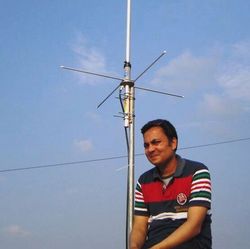
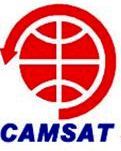 "All six satellites are equipped with substantially the same Amateur Radio payloads, a U/V mode linear transponder, a CW telemetry beacon, and an AX.25 19.2k/9.6k baud GMSK telemetry downlink," the CAMSAT announcement said. CAMSAT said that each Amateur Radio complement has the same technical characteristics, but will operate on different 70 centimeter uplink and 2 meter downlink frequencies.
"All six satellites are equipped with substantially the same Amateur Radio payloads, a U/V mode linear transponder, a CW telemetry beacon, and an AX.25 19.2k/9.6k baud GMSK telemetry downlink," the CAMSAT announcement said. CAMSAT said that each Amateur Radio complement has the same technical characteristics, but will operate on different 70 centimeter uplink and 2 meter downlink frequencies.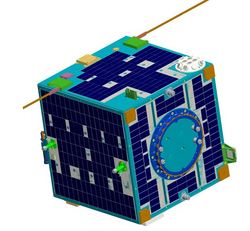
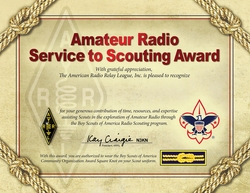 The Amateur Radio Service to Scouting Award was officially established through a resolution that the ARRL Board adopted at its 2013 Annual Meeting. It builds on the long relationship between the BSA and ARRL that began with the development of the Wireless Merit Badge in 1918 -- now the Radio Merit Badge. This relationship was formally recognized through a 2011
The Amateur Radio Service to Scouting Award was officially established through a resolution that the ARRL Board adopted at its 2013 Annual Meeting. It builds on the long relationship between the BSA and ARRL that began with the development of the Wireless Merit Badge in 1918 -- now the Radio Merit Badge. This relationship was formally recognized through a 2011 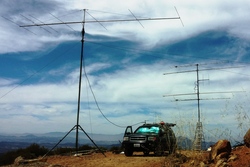
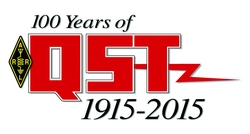 Until August 1, 2015, ARRL members can submit photos for consideration as possible 2015 QST covers. In addition to having their photos grace QST covers, each winner will receive $250.
Until August 1, 2015, ARRL members can submit photos for consideration as possible 2015 QST covers. In addition to having their photos grace QST covers, each winner will receive $250.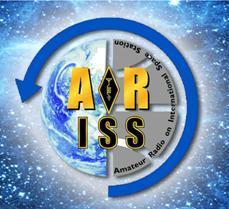 "This is a significant step in ARISS's continuing effort to engage young people in science, technology, engineering, and math (STEM) activities and raise their awareness of space exploration, space communications, and related areas of study and career possibilities," said ARRL Education Services Manager Debra Johnson, K1DMJ.
"This is a significant step in ARISS's continuing effort to engage young people in science, technology, engineering, and math (STEM) activities and raise their awareness of space exploration, space communications, and related areas of study and career possibilities," said ARRL Education Services Manager Debra Johnson, K1DMJ..jpg) PSAT, a USNA student project named in honor of USNA alum Bradford Parkinson, of GPS fame, contains an APRS transponder for relaying remote telemetry, sensor, and user data from remote users and Amateur Radio environmental experiments or other data sources back to Amateur Radio experimenters via a global network of Internet-linked ground stations.
PSAT, a USNA student project named in honor of USNA alum Bradford Parkinson, of GPS fame, contains an APRS transponder for relaying remote telemetry, sensor, and user data from remote users and Amateur Radio environmental experiments or other data sources back to Amateur Radio experimenters via a global network of Internet-linked ground stations.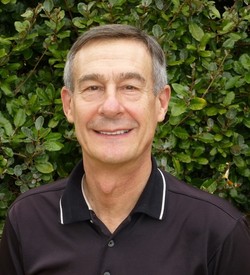
 ARRL Insurance Plan Administrator Changes: The ARRL-sponsored equipment and club liability insurance plans have a new administrator as of May 26. All program administration, including policy application, issuance and claims administration, is now being handled by
ARRL Insurance Plan Administrator Changes: The ARRL-sponsored equipment and club liability insurance plans have a new administrator as of May 26. All program administration, including policy application, issuance and claims administration, is now being handled by 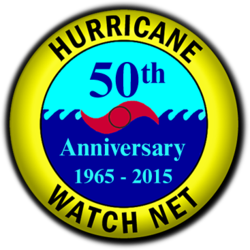 Hurricane Watch Net Sets On-Air Anniversary Celebration: The Hurricane Watch Net (
Hurricane Watch Net Sets On-Air Anniversary Celebration: The Hurricane Watch Net (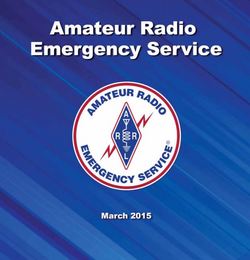 Updated Amateur Radio Emergency Service Manual Now Online The
Updated Amateur Radio Emergency Service Manual Now Online The %20logo.png) Hams Invited to Test APRS on Duchifat-1 CubeSat: The
Hams Invited to Test APRS on Duchifat-1 CubeSat: The .jpg)
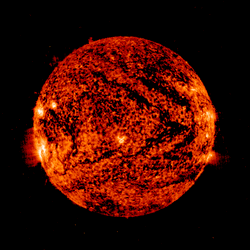 The latest forecast from NOAA/USAF has solar flux at 95 for May 28-29; 100, 120, and 130 for May 30-June 1; 140 for June 2-3; 125 for June 4-5; 120 on June 6; 115 for June 7-10; 110 and 105 for June 11-12; 100 for June 13-14; 95 on June 15; 90 for June 16-17; 95 for June 18-20; 100 for June 21-23, and 95, 90, 105, and 110 for June 24-27. Flux values then peak at only 125 for July 1-2.
The latest forecast from NOAA/USAF has solar flux at 95 for May 28-29; 100, 120, and 130 for May 30-June 1; 140 for June 2-3; 125 for June 4-5; 120 on June 6; 115 for June 7-10; 110 and 105 for June 11-12; 100 for June 13-14; 95 on June 15; 90 for June 16-17; 95 for June 18-20; 100 for June 21-23, and 95, 90, 105, and 110 for June 24-27. Flux values then peak at only 125 for July 1-2.







